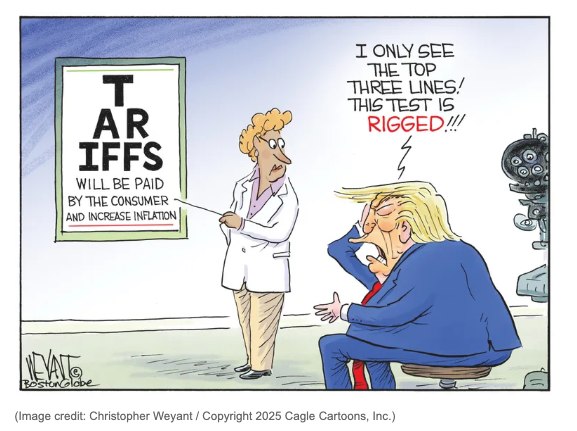Tariffs are not inherently unjust. Thoughtfully designed, targeted tariffs can reinforce key industries, generate domestic jobs, and enhance national strategic capacity. But what we’re witnessing now is a different beast entirely: broad-based, volatile, and poorly timed tariffs that saddle American workers with the heaviest burden.
1. Bite at the Checkout Counter
According to Yale’s Budget Lab, the tariffs enacted in 2025 are projected to raise consumer prices by 2.3%, translating to an estimated $3,800 loss in annual purchasing power per household, and $1,700 for the lowest-income households.Wikipedia+1Harvard Kennedy School+8The Guardian+8Vox+8The Budget Lab at Yale+1
The Port of Oakland, a key trade hub, reported a 31% spike in imports as companies rushed to beat impending duties — a telling sign of market disruptions. San Francisco Chronicle
2. GDP and Job Losses—A Slow Drain on Growth
These tariff measures aren’t benign. Yale projects a drop of 0.5 percentage points in GDP growth in 2025 and 2026, along with ~500,000 fewer payroll jobs by year-end. The Wall Street Journal+3The Budget Lab at Yale+3The Budget Lab at Yale+3 Even with some gains in manufacturing—2% in nonadvanced categories—sectors like construction, agriculture, and mining are expected to contract. The Budget Lab at Yale+1
3. Tariffs as Regressive Taxation
Tariffs, by design, are consumption taxes. The burden is heaviest on low-income families. Yale’s data show that in the short term, the bottom decile bears 3.5% income loss, compared to only 1% for the top decile. The Budget Lab at Yale
4. Battles Won, Wars Lost
Some local wins—like Samsung building a washing-machine factory in Newberry, South Carolina—come at hefty costs. Tariffs pushed up national prices of washers by nearly 12%, costing consumers $1.5 billion per year. The Wall Street Journal+1 While creating modest job growth, these benefits rarely offset the broader economic pain.
5. Historical Echoes and Policy Gaps
Recall the 1930 Smoot–Hawley Tariff Act, blamed by economists for deepening the Great Depression through retaliatory tariffs. Wikipedia+4The Wall Street Journal+4The Budget Lab at Yale+4Wikipedia+1
A 2002 steel tariff under President Bush showed that the costs quickly outweighed the benefits—one analysis revealed job losses of 200,000 in industries that relied on cheaper steel inputs. Wikipedia+1
Similarly, in Trump’s first term, data show that tariffs lost the economy billions while providing only modest manufacturing gains. the-sun.com+15Wikipedia+15Wikipedia+15
6. Counterproductive Outcomes and Policy Instability
Because of policy unpredictability, firms are hesitant to invest, supply chains become volatile, and inflation rises. The Washington Center for Equitable Growth estimates factory cost increases of 2%–4.5%, jeopardizing wages and investment. AP News
An Atlantic analysis criticizes current “trade deals” as little more than symbolic: imposing tariffs of 15% while securing vague investment promises—with few meaningful concessions from partners. U.S. manufacturers continue to face higher input costs and declining competitiveness. theatlantic.com
Conclusion: A Tax on Workers, Subsidy for the Wealthy
In a healthy economy, policies aim to share burdens equitably and boost resilience. The current tariff architecture does not. It structurally shifts cost from corporations and elites to the working class, even as the very policies that benefit the wealthy—tax cuts, bailouts—remain untouched.
Tariffs shouldn’t be the fiscal tool of last resort. Our policymakers must acknowledge that now is not the time for sweeping, brittle trade coercion, but for targeted strategic support, investment in workforce upskilling, and policies that stabilize supply chains—not punishing the people who keep them moving.

